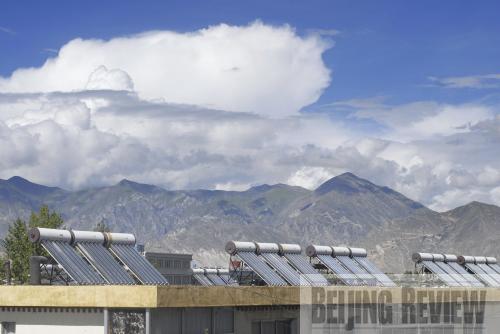|
 |
|
SUN SHOWER: Solar heaters are widely used in Lhasa communities (WEI YAO) |
The 5100 Glacier Mineral Water produced by the Tibet Glacier Mineral Water Co. Ltd., has been exported to Hong Kong, noted Zhang, while Tibet-made barley beer has been exported to the United States.
In the meantime, Tibet has banned the development of heavy-pollution industries, including papermaking, iron and steel, chemical and thermal power. "As for industrial development," said Zhang, "Tibet will not blindly introduce projects just to fill up any industrial gap or for short-term interests."
According to figures released by the TEPB, Tibet has closed nine cement production lines in seven factories, seven small steel factories and four small papermaking mills.
Among them, five production lines in three cement factories within the city limits of Lhasa were all closed. When the autonomous region first closed a cement factory in Lhasa in 2001, the government provided a two-year interest-depreciated loan of 30 million yuan ($4.39 million) with the aim of supporting the factory to shift to other products.
Qiangba Puncog, Chairman of Tibet Autonomous Region, has repeatedly emphasized that Tibet will not develop any thermal power plants, because sulfur dioxide they produce would form acid rain, which would destroy cultural relics in Tibet.
Tibet has also adopted various measures to protect the environment while developing the tourist industry. For example, since 2004, vehicles have not been permitted to reach the base camp of Mount Qomolangma (Mount Everest), and tourists must go by carriage or foot for the last few kilometers to the base camp. Five garbage-collecting stations, additionally, have been built within the base camp area. Garbage and sewage are regularly transported out of the area.
Results of the annual investigation carried out by the TEPB show that around the base camp of Mount Qomolangma, the air is not polluted, and that the air quality is up to the highest grade of the country. Particularly, no sulfur dioxide has been detected, while nitrogen dioxide and total suspended particulates are at very low levels.
Strict administration
Tibet has carried out strict environmental access conditions for construction projects, and strictly administrated development and construction activities. The aim has been to prevent the transfer of projects that produce heavy pollution from other parts of the country to Tibet.
An environmental impact assessment system is strictly enforced in Tibet. Statistics released by the TEPB indicate that since 2001, the region has made more than 3,700 environmental impact assessments on construction projects. Ninety percent of the assessments have been implemented and particularly, among large and medium-sized projects, all the assessments were implemented.
From 2001 to 2008, according to Zhang, Tibet invested 6.46 billion yuan ($945.83 million) in environmental protection and construction, of which more than 1 billion yuan ($146.41 million) was used for improving urban infrastructure for environmental protection and nearly 100 million yuan ($14.64 million) was dedicated to reducing and controlling environmental pollution. In the meantime, it has strengthened monitoring on 30 key enterprises for their environmental impacts.
| 
